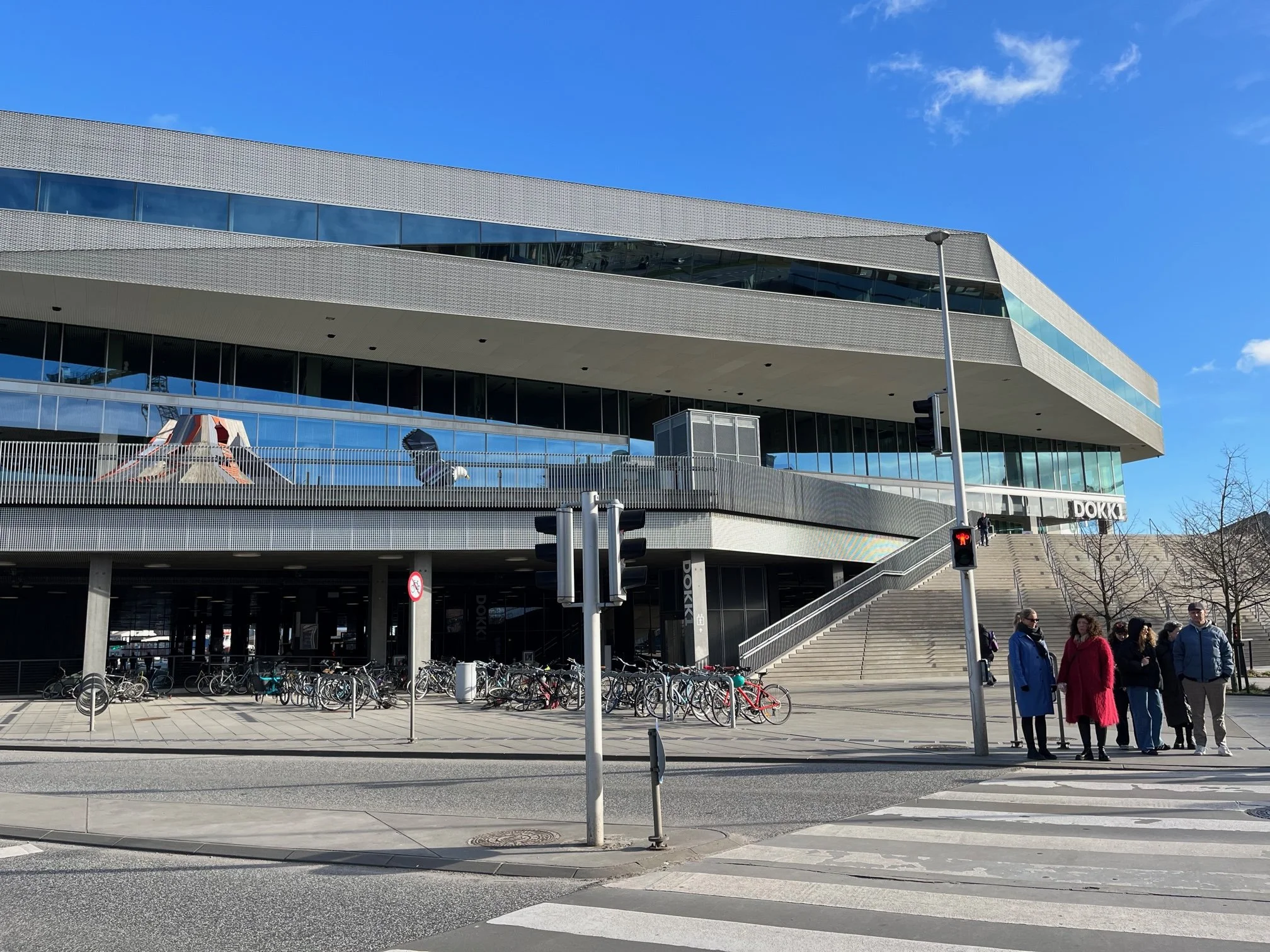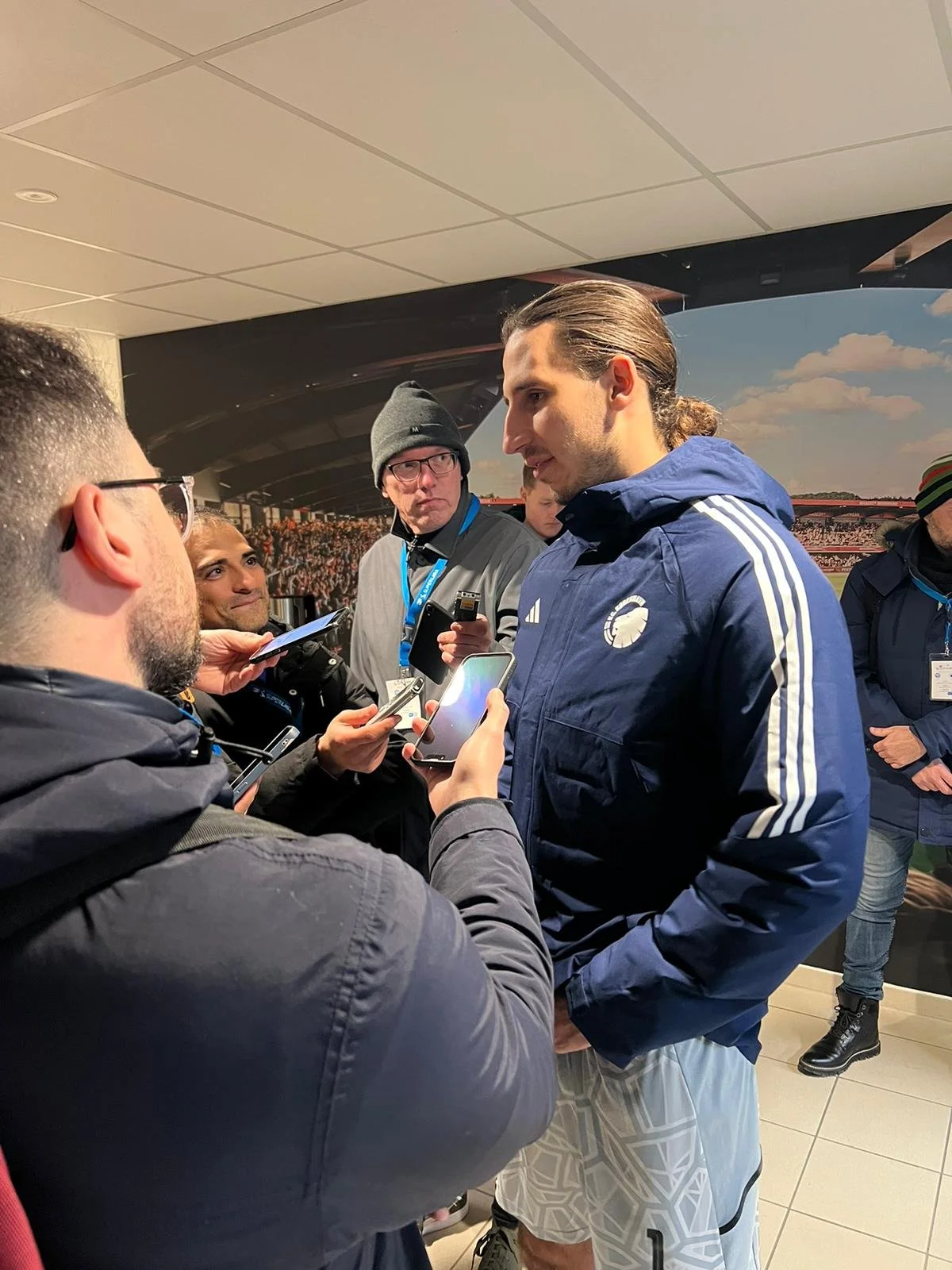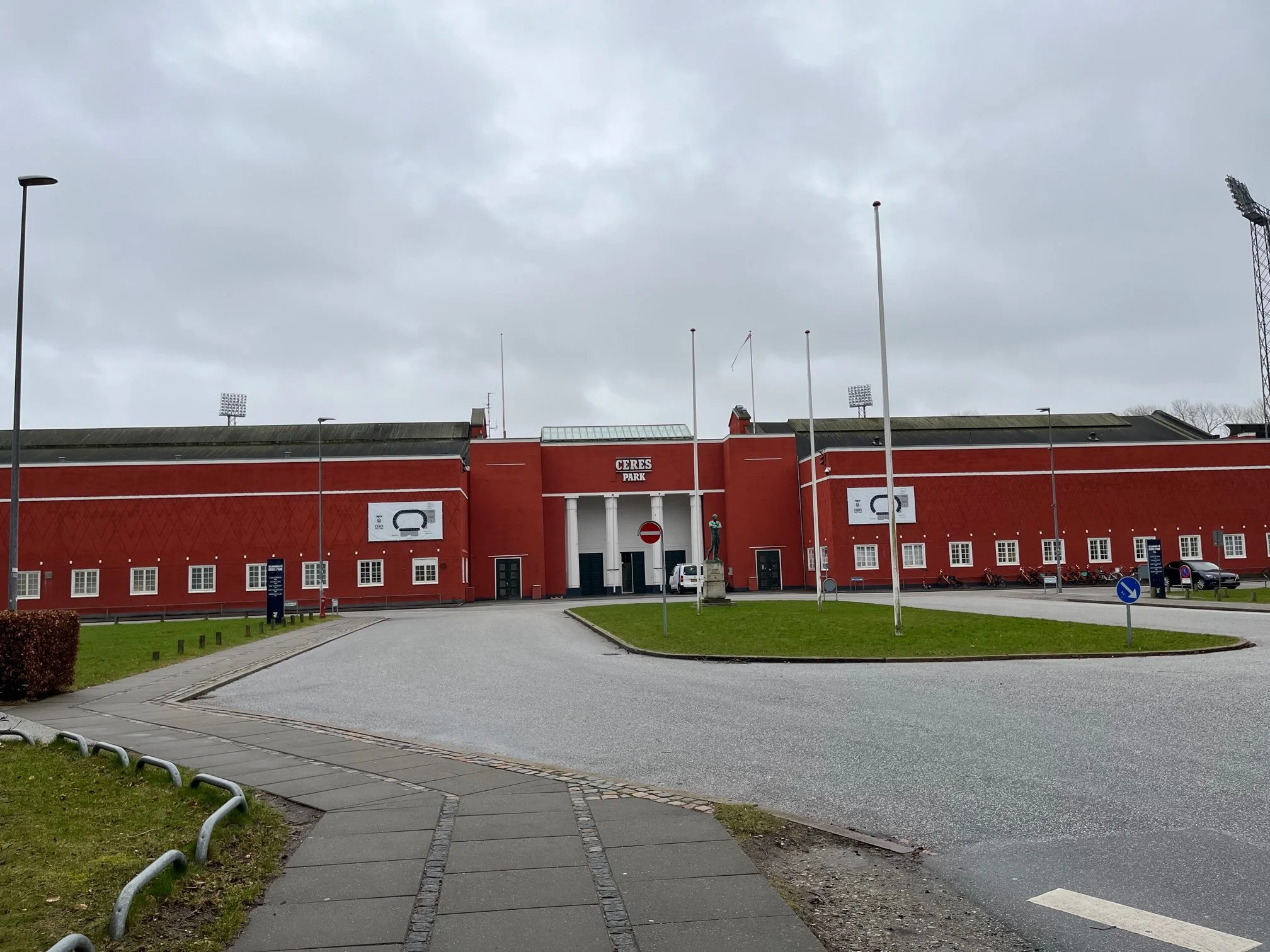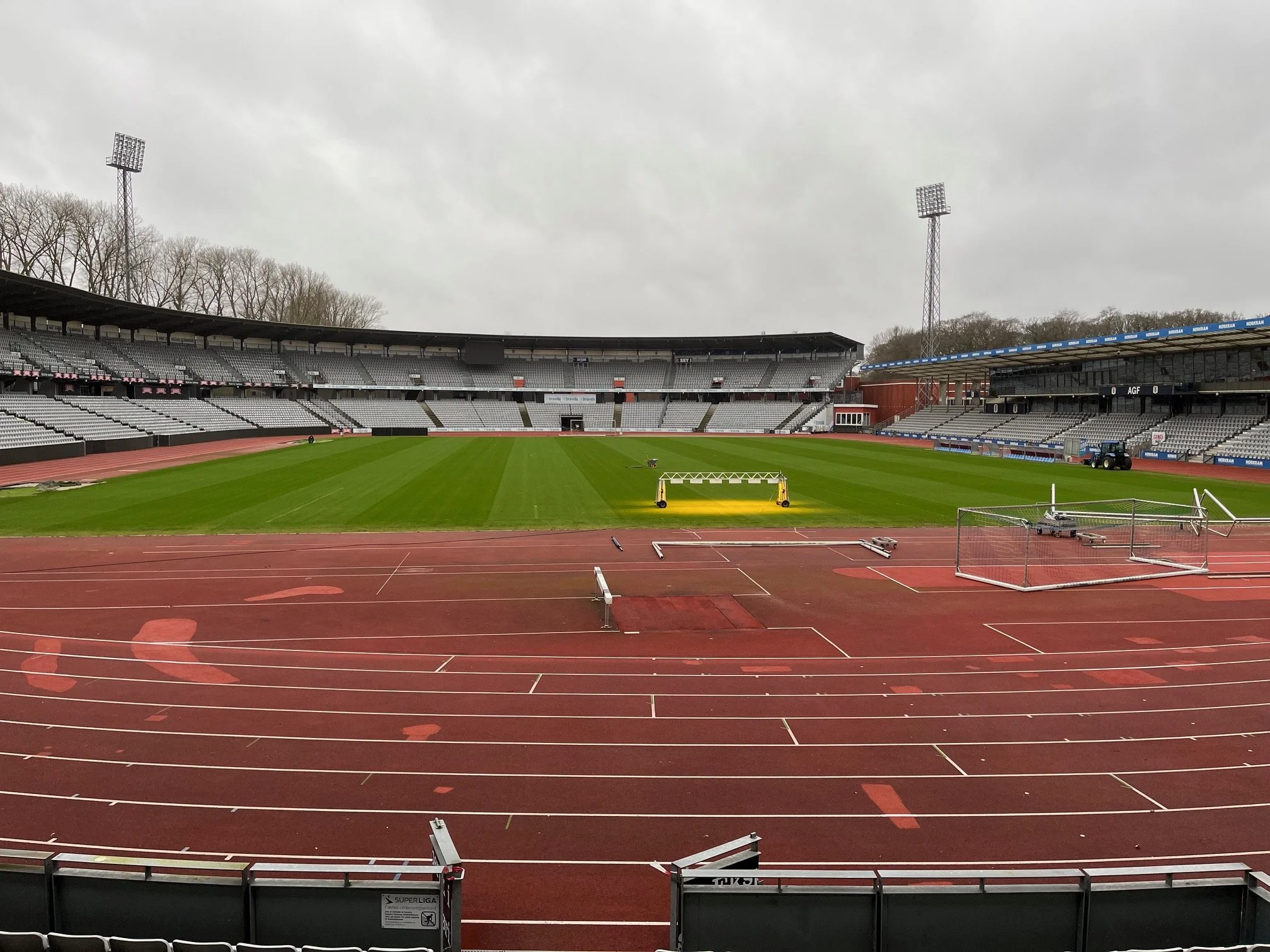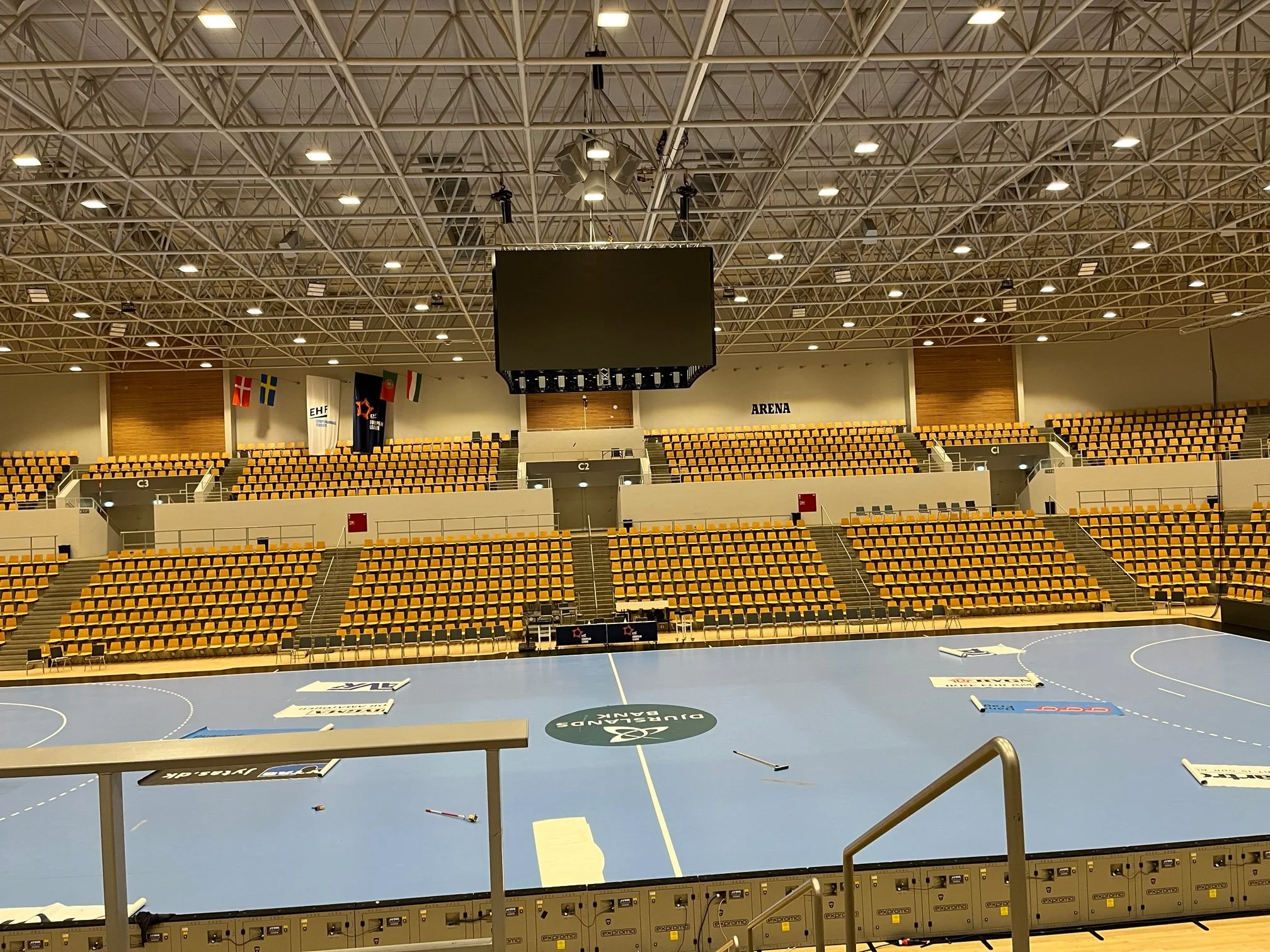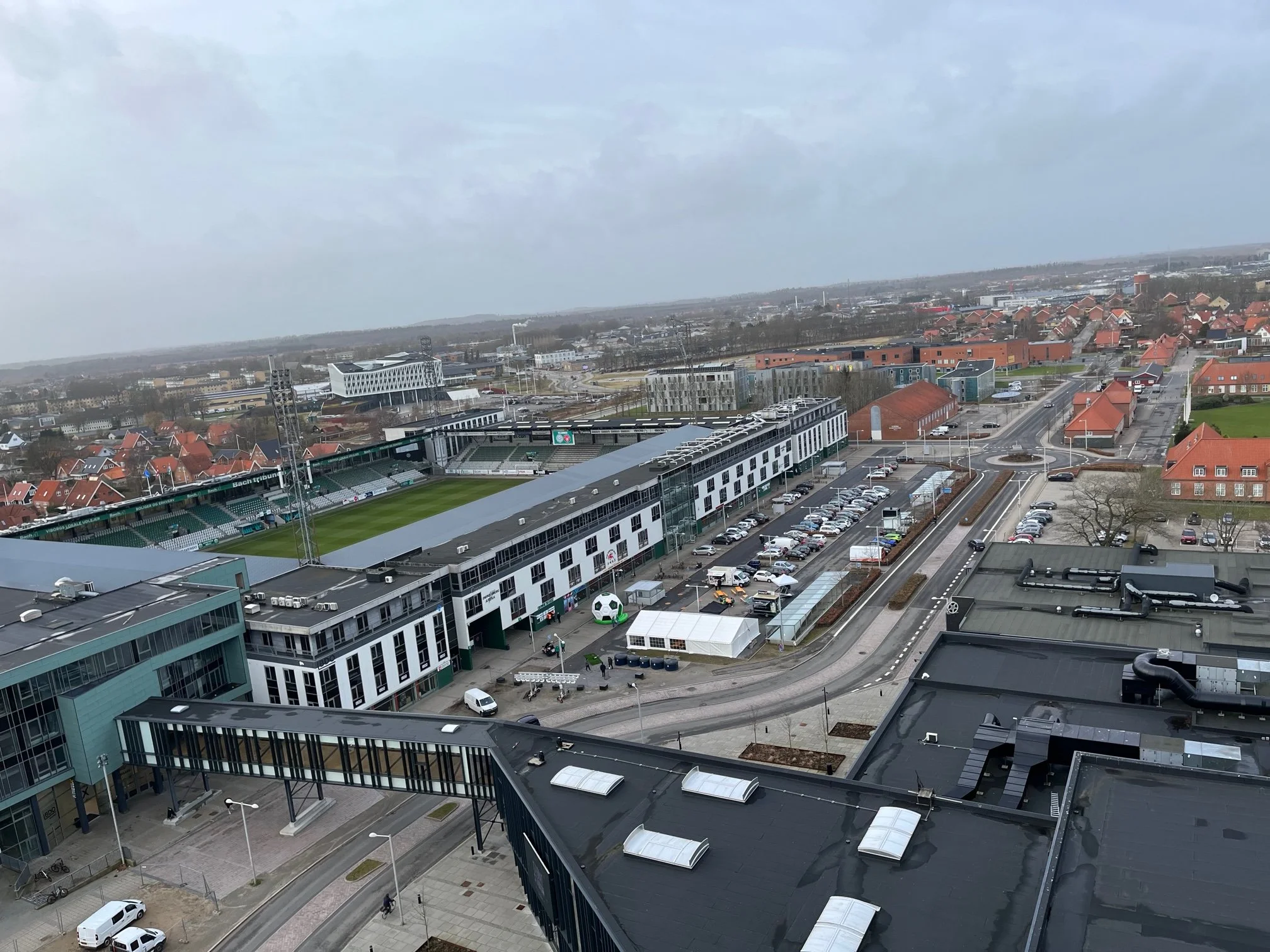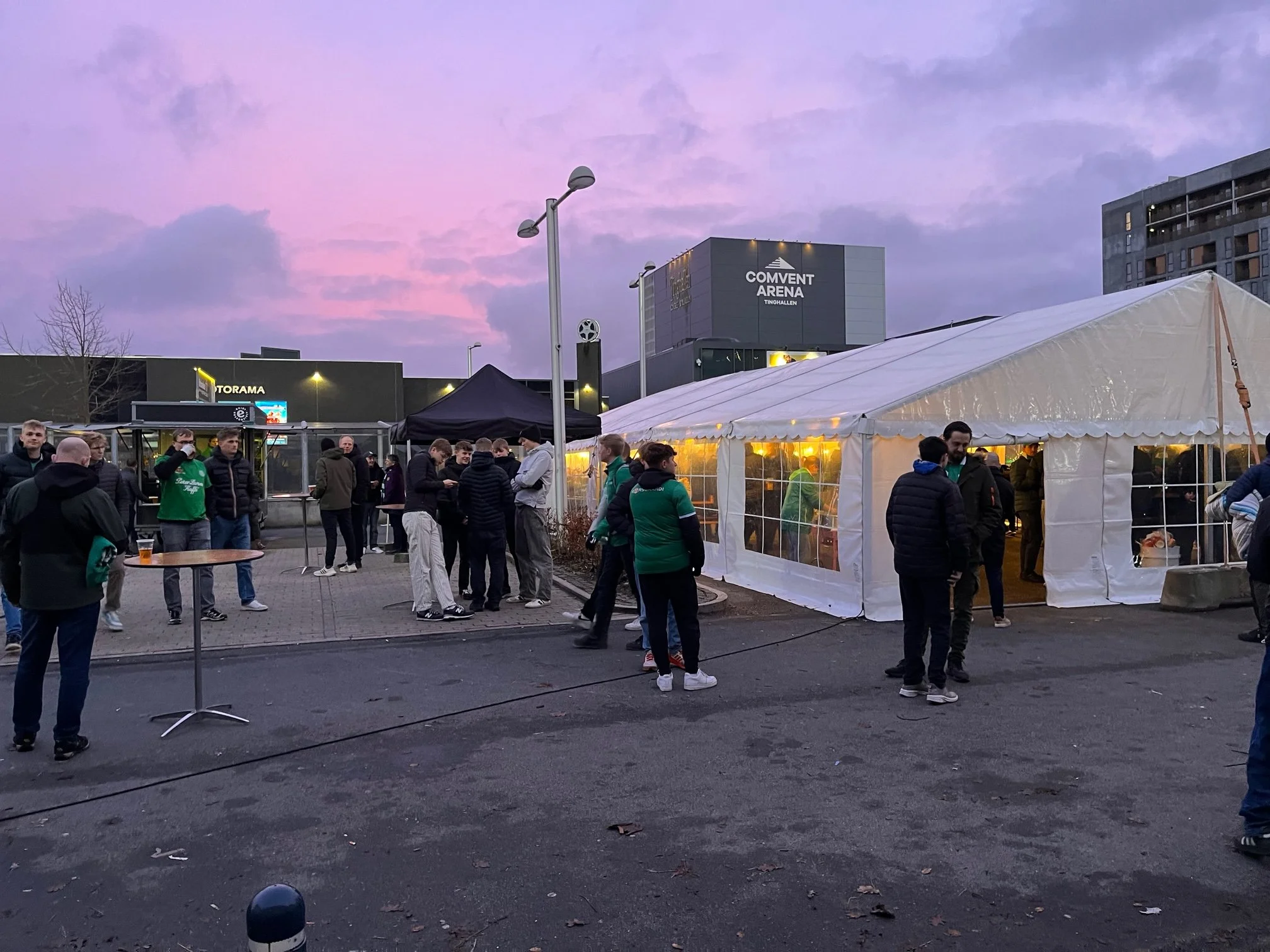Road Trip #3 (2023): A Jylland Double-Header
96 days. Over 2300 hours - or 26% of a year. That’s how long the Superliga’s winter break was. A long, long time to be without Danish football and in that period we’ve seen an entire World Cup, Christmas and transfer window come and go. But as the days slowly (far too slow for my liking in fact) start to get longer I could smell the return of the Superliga and headed to the airport for a 2023 edition of the now customary Danish football road trip.
Joining me on this excursion was a friend of mine, Alex, a fellow Arsenal fan from the UK but living and working in Copenhagen with his wife. The original plan was to hit 3 games in 3 days, beginning with AaB v AGF in Aalborg on Satuday, followed by Silkeborg v FC København on Sunday and Viborg v FC Midtjylland on Monday. My previous encounters with Danish football have all centred around Sjælland, the easternmost island of Denmark and home to the capital, but having experienced the amazing fans of Viborg and Silkeborg in London earlier this season I felt it was a must to go and see them both on home soil. The AaB fixture moved to the Friday and so was taken out of the equation. Getting 3 nights away from home to watch football required some serious negotiation skills. I felt a fourth might be pushing my luck. But with Saturday freed up there was a chance to spend some more time in Copenhagen, a city I never fail to be amazed by.
I arrived in the capital in the wake of Storm Otto which had battered Denmark the night before with wind and heavy rain that threatened to call off the AaB v AGF game. In fact Otto should have been on the scoresheet, having blown a Mikael Andersen corner into the net for the only goal of the game. Stepping off the plane I immediately regretted not bringing a warmer jacket - London’s 10 degrees felt a world away from the biting wind that hit me in Copenhagen. I met up with Alex and friend-of-the-podcast Liam Barker and we immediately reverted to stereotype by making our way to an English pub to watch Arsenal pull off a dramatic last gasp victory at Aston Villa. There’s something surreal but amazing about the fact that the three of us had been brought together by Danish football - the pull of the Superliga should not be underestimated! We spent the rest of the afternoon wandering around the city before grabbing a bite to eat and preparing for an early start the next day.
Sunday morning arrived and we made the short journey to Copenhagen central station for a 3-hour train journey across the country to Jylland - the largest, westernmost landmass of Denmark - where we were planning to base ourselves in Aarhus, the second biggest city in the country. Travelling through Fyn and southern Jylland we glimpsed the AC Horsens stadium en route, its iconic floodlights standing out immediately, and managed to avoid serious injury as our phone chargers continually fell out from their sockets, situated very bizarrely above our heads on the luggage racks.
We pulled into Aarhus with the sun shining and the air fresh and almost immediately saw someone in a Silkeborg shirt, a reminder that matchday was upon us, some 40 miles west of the city.
I’m always blown away by the kindness and generosity people have shown me when I’m in Denmark and this time was no exception, as Jakob, an FCK supporter from Jylland, arrived en route to the game to give us a lift to the stadium. We spent the 40 minute journey talking about the effect new manager Jacob Neestrup had had on the team and assessing the comings and goings in the transfer market. Diogo Gonçalves and Jordan Larsson (son of Swedish legend Henrik) had arrived from Benfica and Schalke respectively and were both vying for a place in the team that afternoon. Silkeborg’s stadium has its own set of eye-catching floodlights, protruding from a stadium that looked like it was wrapped in giant sheets of corrugated iron. It sits right next to the motorway, making travel a breeze and so we parked up, wished Jakob and his friend good luck as they headed into the away end as we made our way to our seats in the press box, situated just to the right of the away team bench.
Before kick-off, Niklas Helenius, last season’s golden boot winner, returned to thank the fans following his January transfer to AaB, the club he first made his name between 2010-2013 having come through the academy and won the league under, ironically, current Silkeborg manager Kent Nielsen.
Seeing the teams warm up in freezing conditions made it all the more obvious why certain teams opt for an artificial surface. The Silkeborg pitch may not be players’ favourite to play on but the carpet-like surface suits their high passing, high possession game perfectly. The water they spray on it pre-kick off makes the speed of the game even faster than on a grass surface. After the game I asked FCK left-back Christian Sørensen what it was like to play on such a surface and how you need to adapt your game. “You don’t have to give the ball much power in your passing - it’s so quick. When you go into pressure it’s more slippery so when you press you can slip or get beaten more easily.”
The game itself was a fascinating affair, with Silkeborg dominating the possession and passing stats as usual but FCK showing a real ruthlessness in front of goal. It was Sørensen who opened the scoring, curling in a free kick from the edge of the box for his first goal for the club since moving from Viborg in the summer. His celebration was emphatic - dropping to one knee and letting out a primal scream - the goal clearly meant a great deal to him personally.
“I had a good feeling today when I saw the the wall was not that tall. I said to Diogo I think the keeper is standing a bit far out so if I can bend it over the wall I think there’s a good chance.” He told me afterwards.
“There was a lot of talk that FCK would sign a new left-back after we sold Viktor [Kristiansen] to Leicester but luckily I got the place today and I think I did quite well. For me it was a personal victory to start today, but also to score and to win. I did everything possible to get into good shape so hopefully in the next 4-5 months I can show there’s no reason to buy another left back for 100m Danish kroner,” he added.
The celebrations from the FCK fans were wild and the travelling contingent remained in full voice - as usual - for the entire 90 minutes. Only a handful of teams travel around the country in such sizeable numbers and the atmosphere they generate is electric. At the other end of the stadium Silkeborg were making their own noise, trying to generate a reaction from their team who looked a little slow out of the blocks after such a lengthy winter layoff.
The second half began and FCK turned up the heat. A sublime one-two between Mo Daramy and Viktor Claesson was finished cooly by the young Dane, a sign perhaps that his confidence is returning after a big money move to Ajax that has yet to pay off for him or his new club. Daramy looked such an exciting talent in Copenhagen before he left early last season so seeing him get back to his best is encouraging for his chances of finding his way back into the national team conversation.
The second goal was quickly followed by a third - a lapse in concentration by Silkeborg centre back Joel Felix led to an underpowered header back to the keeper, putting the ball on a plate for Lukas Lerager to nip in, round the keeper and slot home to put the nail in the Silkeborg’s coffin. New signing Jordan Larsson came off the bench and showed some searing pace down the left wing, while Swedish wonderkid Roony Bardhaji, now committed to the club with a freshly inked contract, came off the bench and once again showed his incredible ability with the ball at his feet. 3-0 it finished and as the players headed to thank their respective fans, Alex and I headed down the tunnel to the mixed zone to grab some interviews.
It’s always a great privilege to get the opportunity to speak to players and managers and one that I never take for granted. Michael Ravn, Silkeborg’s press officer had been extremely generous in London in finding me time with Kent Nielsen, Joel Felix and Niklas Helenius and this time was no exception. It’s always slightly surreal seeing players you watched from the stands minutes before wander past you on the way to the dressing room. When they returned for their post-match media appearances, we joined the scrum for some words from FCK keeper Kamil Grabara, helpfully in English. Keepers by nature of their role have to be self-confident, and Grabara exudes this to the highest degree.
“We only focus on ourselves - win all of the games and we’ll be fine. We put ourselves in the position we’re in now but wherever we go, wherever we play, we play to win.”
In the first half he made a key save and was asked about the significance of such a ‘huge’ stop. “Who said it’s huge? It’s just another one I have to make. If I don’t make those saves we’ll be standing here and you’ll ask ‘do you think it’s your fault?’” How about the fact he kept a clean sheet? “I don’t really care about it, if we win this game 3-1 that will be great too. It’s not something that I think about.”
Before he left he was asked whether he had a message for league leaders FC Nordsjælland. “No. Why would I have any?” he fired back, and with that he left, having shaken hands with everyone - a small gesture but one that, as someone who doesn’t do this often, I noted as a sign of mutual professional respect.
Michael then brought Kent Neilsen over for a chat. Having been on the receiving end of a bad result, Kent had already fronted up to the Danish media and so his willingness to spare me some time to talk further, in English, was one I really appreciated and was indicative of what a warm character he is. He remembered me from the West Ham game where we spoke about his team’s spirited performance at the Olympic Stadium. I asked him about how he keeps the team mentally and physically prepared over such a long break.
“For us, in the first half of the season, we had played 27 matches in 4 months. That was unbelievable so we really needed the break. During the World Cup we kept playing but more to have a fun game. Pre-season started properly on 4th January, which is quite normal, with 5 weeks to prepare. We had 10 days in Spain for training camp and then came back for a week in the lead up to this game.”
He was already in a reflective mood when it came to the game itself. “The big teams with the really good players, they’re able to win matches like this. We know that in some ways we played a good match, we tried to take control of it even though it’s a team with much more value in their squad than we have. But football is about if you’re clinical, if you can take advantage of mistakes and score, and that’s what this match proved again and again.”
I asked him about Tonni Adamsen, the young striker brought in from FC Helsingør in the Danish First Division over the summer, and what he can bring the team in Helenius’ absence. “He’s shorter than Niklas so we don’t use him as much as a target player who we can play out to from the back. But he’s got great pace, so quick passes around the opponent’s centre backs are what he’s really good at. We are very pleased with Tonni, at small clubs we need players that are good at scoring goals, it’s a similar situation with him as it was with Helenius when he arrived.”
I thanked Kent for his time and for bringing such a refreshing style of football to the league - I know Silkeborg have grabbed the attention of many people this side of the North Sea over the course of the last 12 months.
Before leaving the stadium I also managed to get a few minutes with FCK goalscorer Christian Sørensen. Since getting into Danish football 4 or 5 years ago, he’s been one of my favourite players to watch, so having the opportunity to meet him in person and put some questions to him was great. His move to FCK happened quite quickly and he was immediately thrust into the limelight at one of the biggest teams in Scandinavia, with the mental and physical pressure of a title defence and Champions League football. I asked him about the winter break and what it meant for him personally.
“For me it was nice mentally to be off - I just had a second child - but also I think it’s good for football players to stay away from football. To gain the confidence and energy to restart. I didn’t even watch the World Cup - when I’m home I’m a father and I leave the football player in the club house.”
It’s easy to think of players as finely tuned footballing machines but behind each and every player is a personal life and everything that goes with that so it was a welcome reminder of the importance of taking time to reflect and recharge.
Alex and I left with some interviews in the can and an action packed 90 minutes under our belts. Jakob had kindly waited to give us a lift back to Aarhus and we once again spent the duration picking apart the match and discussing what it all meant in the context of the season.
Back in Aarhus we hit the streets in search of a restaurant that was open on a Sunday night - no easy task I can assure you. We eventually made it to a pizza place and refuelled after a long day of football and travel.
The next day Alex headed into town for a day of work while I met up with Patrick, an avid AGF and Denmark fan with a passion for collecting football shirts. Handing me an AGF scarf as a gift (one that came in extremely handy as we wandered through a cold and drizzly Aarhus) we headed for Ceres Park, the home of AGF, sharing countless football stories along the way.
The stadium itself is at the end of a picturesque tree-lined road and from the outset looks completely different to any other stadium I’d seen in Denmark. The stadium, built in 1920, is the third largest in the country and features an athletics track owing to the fact it was constructed by the municipality as a multipurpose sporting venue. We found an open door and wandered around the track looking at the stands as the groundsman worked on the turf, which looked almost pristine despite the cold conditions. The stadium itself feels massive and imposing but the distance between stands and pitch is significant and has been a constant bugbear of AGF fans, who create an amazing atmosphere that feels like it deserves to be closer to the action.
As we headed into the stands for a different perspective, Patrick told me that the use of a ‘Brøndby net’ - the net placed in front of away fans to prevent projectiles - is not really needed at AGF because even if you were stupid enough to throw something you’d probably need to be an olympic athlete to clear the distance required.
Having completed a lap of the stadium we went briefly to the adjoining building, a huge club house featuring the AGF handball arena - also the third largest in Denmark. Handball is immensely popular in Denmark, particularly in Jylland, and such an arena was testament to that. We left and walked back to the centre of town, with the rain beginning to fall more heavily. A new stadium in Aarhus has been proposed, with work due to start in the coming years so a trip to see a game at Ceres Park before it disappears is something I’d love to do.
I said farewell to Patrick as I headed to my hotel to find dry clothes ahead of my train to Viborg for the second and final game of the trip. It’s a short one-hour train journey to Viborg, a historic Danish town that dates back as far as the 8th Century. It was Monday so the place was fairly quiet as I met up with Glenn and his brother Mikkel, two huge Viborg fans I had met in London and who had agreed to show me around. We headed past the famous cathedral and to a brand new hotel which boasted a rooftop terrace offering amazing views of the surrounding area and, perhaps most importantly, the stadium which was set to play host to one of the fiercest derbies in Danish football that evening.
FC Midtjylland (FCM) are the upstarts of Danish football, having formed in 1999 after a merger between two clubs, Ikast and Herning Fremad. Matthew Benham brought them to the attention of the British public when he bought the club and a lot of what he learned in terms of winning through smart scouting and data analytics he has applied to another team he owns - Brentford in the Premier League. Viborg supporters believe they own the right to be known as the main club from Midtyjlland and that Herning, where FCM call home, is in fact situated in Vestjylland (west Jutland). Unfortunately on the day, FC Midtjylland supporters had been banned from attending the fixture having been held responsible for a fire that was started in the previous derby at the stadium. A derby is often made by the back and forth in the stands as much as it is on the pitch so this was certainly a blow to the overall experience but as we met with a large group of Viborg supporters outside a pub in the city for the fan march to the stadium it instantly became clear that there would be no shortage of atmosphere from the home fans at least.
The march itself did not take long to reach the stadium, punctuated by stoppages for songs and what I can only describe as the kind of thunder claps made famous by the Icelandic national team in Euro 2016. As we arrived at the stadium I said goodbye to Glenn and Mikel and wished them luck as I headed in the opposite direction to the media entrance. A fanzone was in place outside the stadium and the fans were clearly buzzing at having meaningful football back after such a long break.
Having collected my accreditation I made my way in and instantly recognised Randers manager Thomas Thomasberg heading to the stands on a reconnaissance mission (later I also spotted FCK manager - and former Viborg boss - Jacob Neestrup). I sought out the media room for some warmth and immediately saw Lars Rønbøg, Superliga photographer extraordinaire and all-round good guy. I took the opportunity for a brief chat before he headed pitchside with a camera the size of a small car. As always, it was nice to see a familiar face - Lars captures the action at hundreds of Danish fixtures each season so there’s always a good chance of running into him wherever I go.
Alex arrived just before kick off and we grabbed the blankets Viborg had helpfully provided to fight off the biting cold as we took our seats on the halfway line. Before kick-off the Viborg supporters in the Sudtribunen revealed an outstanding tifo depicting a number of Viborg heroes, with current captain (and former Danish Dyna-Mic guest) Jeppe Grønning in the centre. Surrounded by green and white flags and with flares illuminating it from behind, this was one of the most impressive tifos I’ve seen in person and really underlined just what a remarkable story this current Viborg team was.
On the pitch however, FCM were very much in the driving seat, with youngster Aral Simsir bursting through on goal, dinking the keeper and new signing Ashour blasting the ball in from a yard out. If this had happened in a Sunday league game there would have been furious arguments over the ‘theft’ of a goal but in the professional game you can’t leave anything to chance and Ashour’s second goal in two games since arriving from Egypt in the January window was just reward for his work in the first half. For the home side, Tunisian Elias Achouri looked bright down the left-hand side but Viborg were missing the focal point of their attack, with striker Jay-Roy Grot having been sold in January to Kashiwa Reysol in the J1 League in Japan. His replacement Alassana Jatta worked hard but didn’t have the same presence to cause FCM problems.
Half-time came and went, with both managers shuffling the pack with some changes, but it was the young winger Gustav Isaksen who shone brightest, taking the plaudits for an outrageous hatrick that truly put the tie to bed. The first, a well placed side-footed effort into the top corner after some great work from Swede Kristoffer Olsson on the counter attack. The second, a sublime curled effort into the far post from the edge of the box and the third, moments later, the best of the bunch as he fired a fierce low volley from the edge of the box into the bottom corner of the net via the post. Isaksen’s talent this season has been impossible to ignore, with a standout performance against Lazio in the Europa League turning heads across Europe, but questions remained as to whether he could produce on this level consistently. With star men Anders Dreyer and Evander both departing in January the onus has been on Isaksen to step up and he did so with aplomb in Viborg.
Afterwards I spoke to him and asked about the goals. “In the past couple of games I’ve been dribbling too much when I had the chance to shoot so today my mindset was to shoot whenever I had the chance and I think I fulfilled that!”
I also asked whether a performance like that had him thinking about a place in Kasper Hjumland’s national team set up in the near future.
“That would be a dream for me but my mind can’t be in that place right now. We’ve got some really difficult games ahead - but if I keep performing maybe it will happen some day.”
With such a tight battle for the title this season I also wondered whether he felt like this result had them thinking about the possibility of the gold medal.
“Haha no, it’s too early. We just need to be in the top 6 then we can start hunting with nothing to lose,” he said before disappearing ahead of the short journey home.
I also spoke to FCM captain Erik Sviatchenko, a club legend who had a spell in Scotland with Celtic and who can credibly lay claim to be the best dressed player in the Superliga. I asked him about the club’s preparations over the winter break.
“I love that we could see over 90 minutes what we had been working on. Of course we lost two of the most important players of the past few years - we knew that it would happen but also we have a clear concept where we know what we need to do on the pitch so it’s easier for the new guys who come in. When we win 4-0 it’s a bit easier to let them go and move forward!”
After speaking to Erik, Viborg captain Jeppe Grønning came over to say hello. I first spoke to Jeppe on the inaugural episode of Danish Dyna-Mic and he was such an interesting and engaging character - a hugely knowledgeable student of the game and a loyal servant to the club he has represented over 300 times. After a 4-0 derby defeat I would have forgiven him for heading straight back to the changing room after his Danish media duties. The fact he stuck around to talk to me is something that meant a great deal and was a real reflection of what a generous guy he is. Unlike my other post-match conversations I didn’t record anything and we talked openly and honestly about the game. As we said goodbye, I tried to boost his spirits by reminding him that Viborg were still 2nd and it was their first defeat since the West Ham game in August.
I thanked Nicolai, Viborg’s press officer who has also been extremely generous in supporting Football In Denmark over the previous months, and headed into the Viborg night with Alex, towards the train station. The town was now virtually deserted, aside from a group of girls with Viborg flags still singing as they marched through the centre of town. It was a one hour wait until the next train, with a change required en route, so we huddled in a freezing glass box on the station platform and waited for what felt like an eternity.
Once we boarded our train back to Aarhus, we got chatting to Christian, a Viborg fanatic who studies in Aarhus. He was obviously disappointed about the result but was able to put it into the context of his time as a Viborg fan, recognising that this remains one of the most exciting times the club has seen and that they still have a very credible chance of reaching Europe for a second successive season. So unlikely was their European adventure this season that he missed a large chunk of the Europa Conference League fixtures with an extended summer holiday. He assured us he wouldn’t be making the same mistake this summer should they reach the competition’s qualifying stages again.
As my head hit the pillow back at the hotel I glanced at my watch - it was past almost midnight and I had covered 28,000 steps - 20km - between Aarhus and Viborg. Almost as soon as my eyes closed my alarm rang at 5:30am as I wearily packed my bag and met up with Alex, looking distinctly more spritely, as we headed for our train back to Copenhagen. I breezed through the airport and onto my plane home - back to reality and with an action-packed weekend of football memories.
Every time I come to Denmark I’m blown away by how friendly, helpful and generous people are in my pursuit to learn more about Danish football and document the Superliga for an English-speaking audience. From Alex’s generous hosting, to Patrick, Glen and Mikkel’s guided tours, to Jakob’s ride to and from Silkeborg it was a huge pleasure to spend time in the company of others who share this passion of mine. I’m also hugely grateful to the clubs themselves for allowing me to document the stories that make the Superliga so fascinating - I really hope it’s helping to bring others who don’t speak Danish closer to the action.
I value my marriage too much to put in a request to my wife for another trip this season but I’m already thinking about what’s next in the autumn or winter. Seeing the Copenhagen derby in Brøndby is surely the one big experience still missing from my Danish football CV. But visiting Aalborg (‘The Paris Of The North’) and Odense are also both high on my list. One thing is for sure, there’s plenty more Superliga football to be watched.



